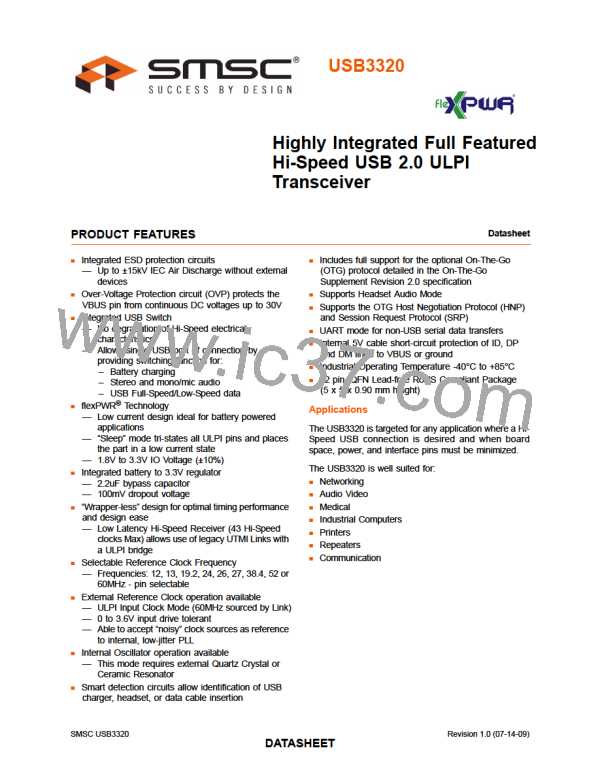Highly Integrated Full Featured Hi-Speed USB 2.0 ULPI Transceiver
Datasheet
4.10
Piezoelectric Resonator for Internal Oscillator
The internal oscillator may be used with an external quartz crystal or ceramic resonator as described
in Section 5.4.1.2. See Table 4.11 for the recommended crystal specifications. See Table 4.12 for the
ceramic resonator part numbers for commercial temperature applications. At this time, the ceramic
resonator does not offer sufficient temperature stability to operate over the industrial temperature
range.
Table 4.11 USB3320 Quartz Crystal Specifications
PARAMETER
SYMBOL
MIN
NOM
AT, typ
Fundamental Mode
Parallel Resonant Mode
MAX
UNITS
NOTES
Crystal Cut
Crystal Oscillation Mode
Crystal Calibration Mode
Frequency
Ffund
-
Table 5.10
-
MHz
PPM
pF
Total Allowable PPM Budget
Shunt Capacitance
Load Capacitance
-
-
±500
Note 4.10
CO
CL
-
7 typ
-
-
20 typ
-
pF
Drive Level
PW
R1
0.5
-
-
mW
Ohm
oC
Equivalent Series Resistance
Operating Temperature Range
-
-
-
30
Note 4.11
-
Note 4.12
-
USB3320 REFCLK Pin
Capacitance
3 typ
pF
Note 4.13
Note 4.13
USB3320 XO Pin Capacitance
-
3 typ
-
pF
Note 4.10 The required bit rate accuracy for Hi-Speed USB applications is ±500 ppm as provided in
the USB 2.0 Specification. This takes into account the effect of voltage, temperature, aging,
etc.
Note 4.11 0oC for commercial applications, -40oC for industrial applications.
Note 4.12 +70oC for commercial applications, +85oC for industrial applications.
Note 4.13 This number includes the pad, the bond wire and the lead frame. Printed Circuit Board
(PCB) capacitance is not included in this value. The PCB capacitance value and the
capacitance value of the XO and REFCLK pins are required to accurately calculate the
value of the two external load capacitors.
Table 4.12 USB3320 Ceramic Resonator Part Numbers
FREQUENCY
MURATA PART NUMBER
NOTES
24 MHz
26 MHz
CSTCE24M0XK1***-R0
CSTCE26M0XK1***-R0
Commercial Temp Only, Note 4.14
Commercial Temp Only, Note 4.14
Note 4.14 This is a generic part number assigned by Murata. The oscillating frequency is affected by
stray capacitance on the Printed Circuit Board (PCB). Murata will assign the final part
number for each customer’s PCB after characterizing the customer’s PCB design.
Revision 1.0 (07-14-09)
SMSC USB3320
DATA2S2HEET

 SMSC [ SMSC CORPORATION ]
SMSC [ SMSC CORPORATION ]